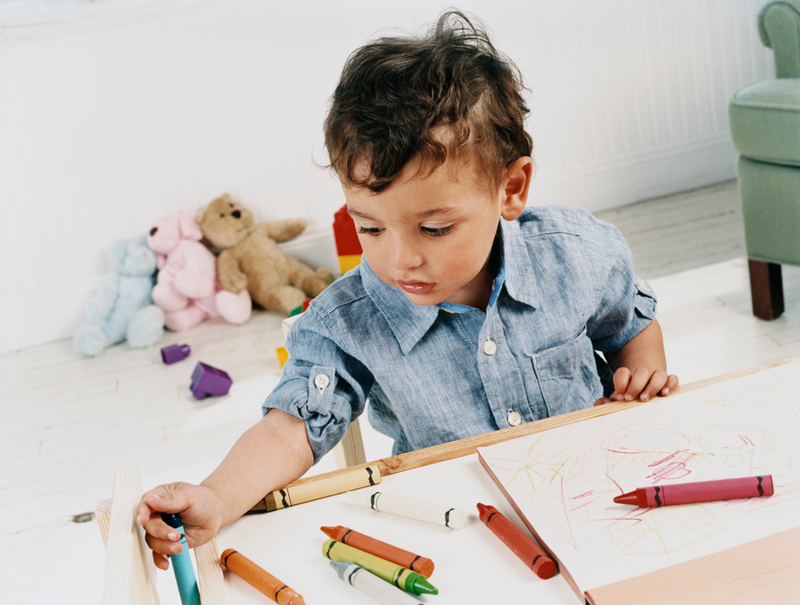
While you may seem some of the same materials on the shelves, Toddler Montessori classrooms are not just simpler Early Childhood classrooms, no more than Early Childhood classrooms are just Toddler classrooms with a bigger crowd. These spaces respond to distinctly different needs in children's development. How can you tell which one will serve your child better?
Toddler classrooms generally have a lower student:teacher ratio, typically six children for each adult. This ratio is one of the key indicators of the different "life" of a toddler classroom. Toddler classrooms are designed to support children as they move from the wonder and newness of infancy to the agency and social engagement of Early Childhood. In this middle space, toddlers need lots of opportunities to practice doing things themselves, to master the coordination of moving their bodies and managing their own basic needs. It's a time when things stop being done to the child and start being done by the child: toileting, feeding, dressing, etc. They are socially curious, but often mimickers, repeating what they see other peers or teachers do. They may show windows of great concentration, but the attention span of a toddler is a bit like a pile of glitter: beautiful to look but nearly impossible to restore if it's disturbed.
Early Childhood classrooms, on the other hand, are far more complex social environments. The multiage classroom means that children may have a full three years difference between the youngest and oldest children in the space. There are often twice as many children or more, and the student:teacher ratio doubles. Early Childhood classrooms are designed to support the "society by cohesion," when children come to rely on each other for the peaceful unfolding of their community, in which each child has agency and influence. The most important relationships in the Early Childhood classroom are between the children, as they build their ability to attend, to coordinate their bodies in complicated ways, to order their intellect and to be independent contributors to their community. While toddler classroom materials allow the child to build the physical skills to manage and regulate their own work, Early Childhood classrooms put those skills to work in classifying, sorting, naming, and manipulating endless new content.
An older toddler, at 30 months or so, may be served in either setting. Choose toddler if the child is still developing their physical self-regulation, if they are not yet interested in toileting independently, if they rely on adults for basic dressing, etc. Choose toddler if they need to climb and tumble during the day, if they need access to climbers and tunnels throughout the day and not just at scheduled times. If they are primarily focusing on their gross motor development, choose toddler. Look to see how they move their bodies when they're drawing or painting, for example. If they hold a brush in the base of their hands and move their arms from the shoulder, they are still best served in the toddler classroom, where they can continue to practice their gross motor skills and support them with increasingly small tools. If they can hold a crayon in three fingers and move their hands to draw or paint instead of their whole arms, they may be better served by the more nuanced materials of the Early Childhood classroom. Remember: both classrooms can be equally intellectually engaging. Both can be equally verbal. Both can support children's emerging mathematical minds. The Early Childhood classroom places a young child at the youngest end of a complex social setting and considers their development within that full three year cycle. The Toddler classroom focuses more on the immediate needs of the young child, distinct from their contribution to a larger group and with more reliance on teachers and other adult caregivers.
Placing children is an inexact science, and it's difficult to detail the complex interactions of individual development and group dynamics that go in to determining which placement may be best for one child or another. Remember that your chid's placement should be based on your child's needs. You've chosen Montessori precisely because it offers an individually responsive model that prioritizes what we can observed in the development of the actual children we serve: don't undervalue that by comparing your child too tightly to anyone else in the room. Instead, remember that, in a model with multiyear, multiage classrooms, teacher-scientists who are professionally educated to observe child development and environments carefully prepared to respond, your child's needs are going to be met at their own time. Use the question of when and how your child may transition as a chance to further build a collaborative relationship between yourself, your child's teachers and other caregivers in the school. The better you can dialogue together about what each of you sees and knows about your child, the more likely you are to get these kinds of decisions right.
#Conference #ForParents #Transitions #FirstPlane #Toddlers #Primary #Theory
